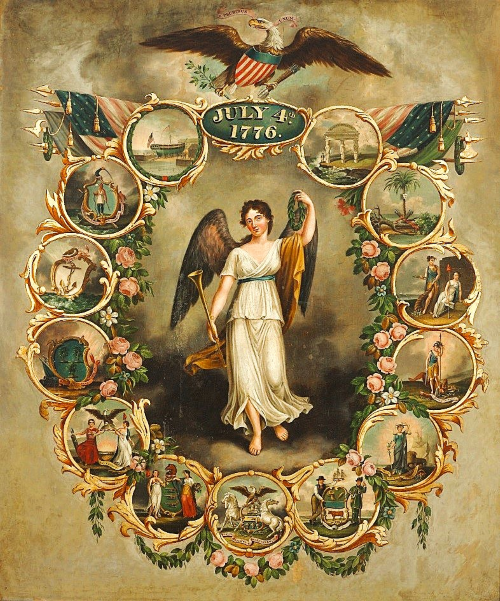OHS is planning special exhibitions as well as dedicated events and lectures throughout 2026 to commemorate the 250th anniversary of our country’s founding, which will provide a special opportunity for the community to explore, consider, and celebrate what our nation and Oysterponds mean to them.
This year-long program will highlight how the 18th century residents of present-day East Marion and Orient lived through a challenging time of divided loyalties and hardships and ultimately emerged battered but triumphant.
The painting below—the largest in the OHS collection—represents a noteworthy example of a Revolutionary War-themed art. Presently occupying a central place in the downstairs hallway of OHS’s Webb House, it celebrates Independence Day and is signed J. A. Woodside and dated July 5, 1832—56 years and one day after the momentous event it commemorates. The center of the painting is dominated by a large, winged female figure. At the time it was painted, no single allegorical figure had been definitively established to represent the ideals of the new republic; the figure here, however, most likely represents Liberty or Columbia.

“July 4, 1776” – J. A. Woodside. Oil on wood, 1832. 54 ½ x 45 ½ inches.
Forming a circle around the central figure are 13 roundels, each depicting the state seal of one of the original 13 colonies and arranged counterclockwise in geographical order, beginning with New Hampshire at the left of the central ellipse that frames the date July 4, 1776, and ending with Georgia. At the top, a large bald eagle with the elements of the seal of the United States spreads its wings over much of the painting. Flags add even more patriotic symbols. The roundels are surrounded by elaborate acanthus-like frames and are entwined with roses, leaves, swags, and other flowers.
John Archibald Woodside (1781-1852) was born in Philadelphia and, in the first half of the 19th century, became the best-known and most sought-after sign and coach painter in that city. He may have studied with Philadelphia artist Matthew Pratt, who himself had studied in London with Benjamin West (as did Oysterponds artist Abraham J. D. Tuthill). Although Woodside painted signs, fire buckets, regimental colors, banners, drums, and coaches, he is best known for his fire-engine panels and may have been the first to decorate a locomotive. He also exhibited easel paintings at the Pennsylvania Academy of the Fine Arts between 1817 and 1836.
Also, don’t forget the 1776AR: REVOLUTIONARY WAR AUGMENTED REALITY TOUR is accessible 24 hours a day, 365 days a year. The 1776AR app uses next-generation digital storytelling to guide visitors on a fascinating 30-minute augmented reality tour guided by key Revolutionary War-era community figures. Visitors simply download the app to their iPhone, iPad or android device and point their cameras at designated spots on the OHS campus to launch the experience. Click here for more info.
![]()
Celebrate Suffolk County’s Role in America’s 250th Anniversary – visit www.Suffolk250.org
Join us in commemorating the 250th anniversary of the signing of the Declaration of Independence with a year-long series of events across Suffolk County! As one of the most historic regions in New York, Suffolk County played a pivotal role in the American Revolution. From colonial-era homesteads to battlefield sites, our rich history comes to life through reenactments, lectures, tours, festivals, and family-friendly activities.
Long before the Revolution, this land was home to the Indigenous peoples of the region, including Shinnecock, Montaukett, and Unkechaug Nations, who played a vital role in shaping the history of Long Island. We have many opportunities to delve into the intriguing ways that European settlers and Indigenous peoples contributed to our unique story in profound ways.
Explore our 250th Anniversary Event Calendar to discover the many ways you can engage with history. Visit our historic sites, where you can walk in the footsteps of our ancestors and experience the spirit of 1776 firsthand. Whether you’re a lifelong resident or a first-time visitor, this is a once-in-a-lifetime opportunity to connect with the past and celebrate the legacy of American independence right here in Suffolk County.
Check back often as new events are added and be sure to follow along as we honor our shared history. Plan your visits today and be part of this unforgettable milestone!
To commemorate this historic occasion, the Suffolk County 250th Commemorative Planning Committee created a special 250th Passport Book. This keepsake book invites residents and visitors alike to explore Long Island’s Revolutionary War sites, 18th-century landmarks, special exhibits and events in Suffolk and Nassau counties. Travel through Long Island’s historic towns, visit participating museums and heritage sites throughout 2026, and collect a unique commemorative stamp at each stop. When complete, your passport becomes both a personal souvenir and a symbol of America’s 250th Anniversary.
The passport book was created by the committee as a public service and is sold “print on demand” and royalty-free from Amazon.com. Each softcover book is $8.32.